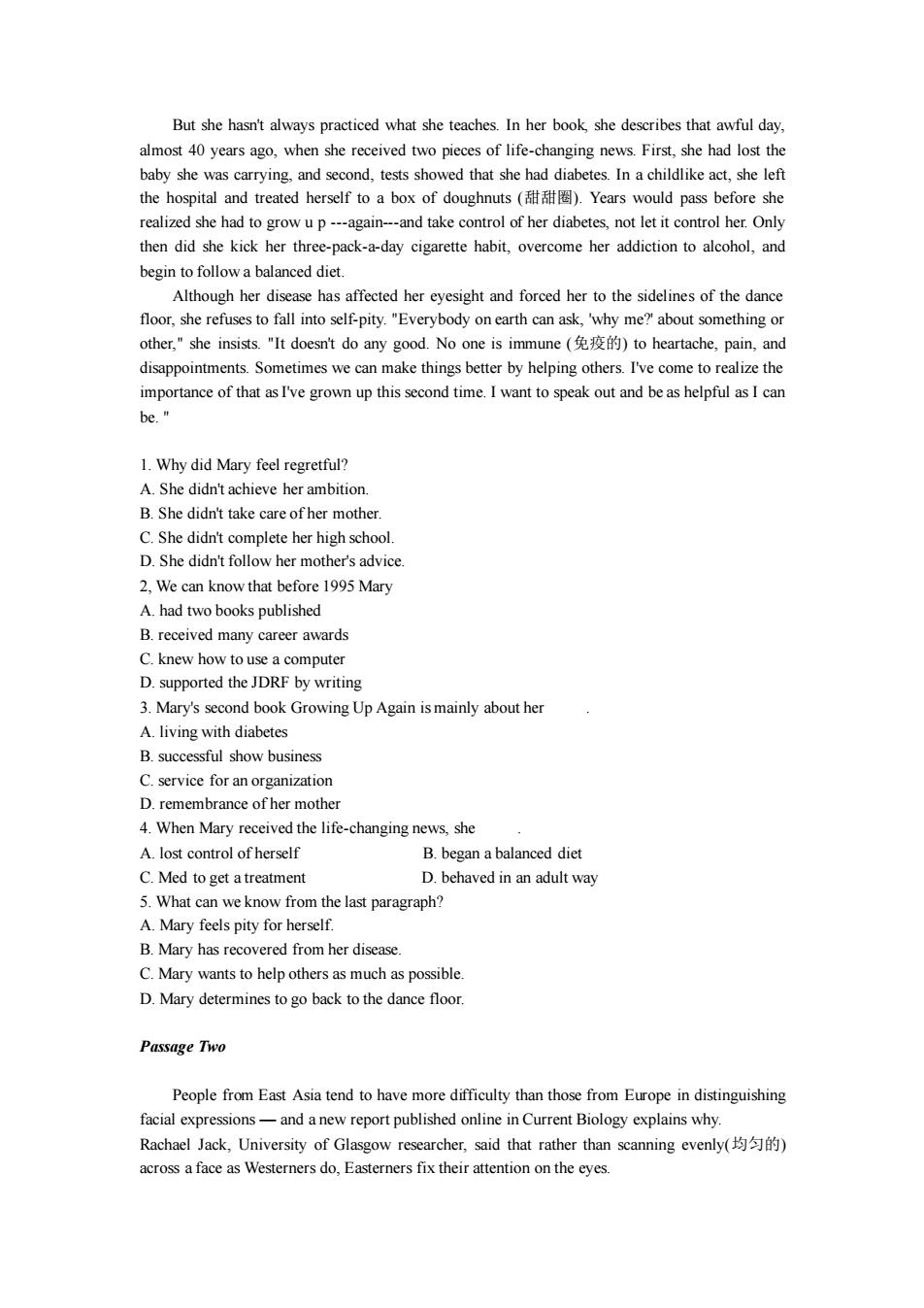正在加载图片...

But she hasn't always practiced what she teaches.in her book she describes that awful dav almost 40 years ago,when she received two pieces of life-chang ging news First,she had ost th baby she was carrying,and second,tests showed that she had diabetes.In a childlike act,she left the hospital and treated herself to a box of doughnuts ()Years would pass before she realized she had to grow u p-again-and take control of her diabetes,not let it control her.Only then did she kick her three-pack-a-day cigarette habit.overcome her addiction to alcohol.and begin to follow a balanced die though her dis ase has affected her eyesight and forced her to the sidelines of the dance floor,she refuses to fall into self-pity."Everybody on earth can ask,why me?about something or other."she insists."It doesn't do any good.No one is immune (to heartache.pain.and disappointments.Sometimes we can make things better by helping others.I've come to realize the importance of that asI've grown up this secnd time.I wantto eak out and be as helpful as i can be." 1.Why did Mary feel regretful? A.She didn't achieve her ambition B She didn't take care of her mothe C.She didn't low her mother's a 2.We can know that before 1995 Mary A had two books published B.received many career awards 3.Mary's second book Growing Up Again is mainly about her A.living with diabetes B successful show business C service for an organizatio 4.When Mary received the life-changing news,she A.lost control of herself B.began a balanced diet C Med to get atreatment D.behaved in an adult way 5.What can we know from the last paragraph? A.Mary feels pity for herself B.Mary has recovered from her disease C.Mary wants to help others as much as possible D.Mary determines to go back to the dance floor Passage Two People from East Asia tend to have more difficulty than those from Europe in distinguishing facial expressions and a new report published online in Current Biology explains why. Rachael Jack,University of Glasgow researcher,said that rather than scanning evenly() across a face as Westerners do,Easterners fix their attention on the eyesBut she hasn't always practiced what she teaches. In her book, she describes that awful day, almost 40 years ago, when she received two pieces of life-changing news. First, she had lost the baby she was carrying, and second, tests showed that she had diabetes. In a childlike act, she left the hospital and treated herself to a box of doughnuts (甜甜圈). Years would pass before she realized she had to grow u p -again-and take control of her diabetes, not let it control her. Only then did she kick her three-pack-a-day cigarette habit, overcome her addiction to alcohol, and begin to follow a balanced diet. Although her disease has affected her eyesight and forced her to the sidelines of the dance floor, she refuses to fall into self-pity. "Everybody on earth can ask, 'why me?' about something or other," she insists. "It doesn't do any good. No one is immune (免疫的) to heartache, pain, and disappointments. Sometimes we can make things better by helping others. I've come to realize the importance of that as I've grown up this second time. I want to speak out and be as helpful as I can be. " 1. Why did Mary feel regretful? A. She didn't achieve her ambition. B. She didn't take care of her mother. C. She didn't complete her high school. D. She didn't follow her mother's advice. 2, We can know that before 1995 Mary A. had two books published B. received many career awards C. knew how to use a computer D. supported the JDRF by writing 3. Mary's second book Growing Up Again is mainly about her . A. living with diabetes B. successful show business C. service for an organization D. remembrance of her mother 4. When Mary received the life-changing news, she . A. lost control of herself B. began a balanced diet C. Med to get a treatment D. behaved in an adult way 5. What can we know from the last paragraph? A. Mary feels pity for herself. B. Mary has recovered from her disease. C. Mary wants to help others as much as possible. D. Mary determines to go back to the dance floor. Passage Two People from East Asia tend to have more difficulty than those from Europe in distinguishing facial expressions — and a new report published online in Current Biology explains why. Rachael Jack, University of Glasgow researcher, said that rather than scanning evenly(均匀的) across a face as Westerners do, Easterners fix their attention on the eyes